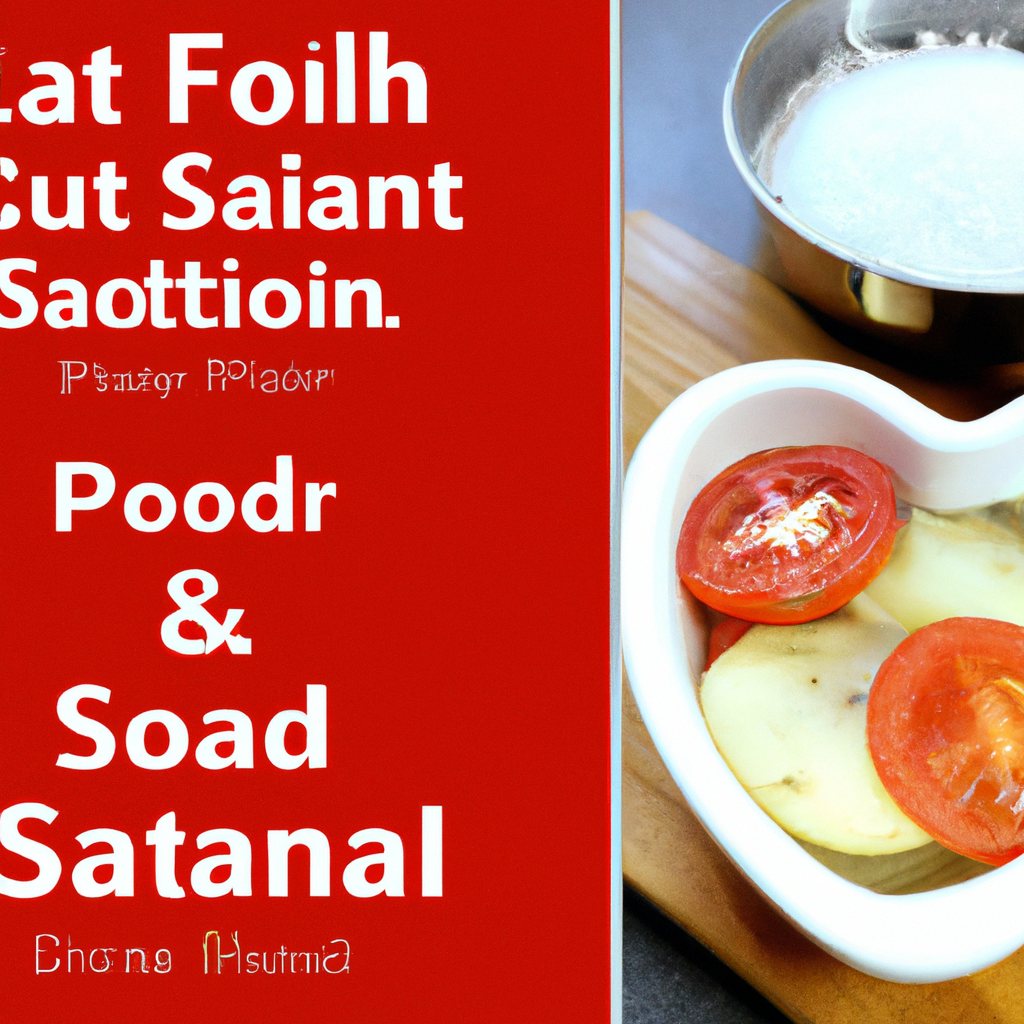The heart is the symbol of life, yet it’s often a source of worry. But for many, the foundation of a healthy heart starts with the food on our plates. With the right cooking techniques, you can create heart-healthy meals that taste delicious without adding too much salt or fat. Read on to learn about a few tips for reducing sodium and saturated fat in your cooking!

1. They Key to Heart-Healthy Cooking: Reducing Sodium and Fat
Cooking with healthy ingredients can seem daunting, but it doesn’t have to be! Reducing sodium and fat in your meals is key to helping you maintain a heart-healthy diet. Here are some simple yet tasty tips you can use to ensure your meals are healthier:
- Season with alternative herbs and spices. Rather than using salt to flavor dishes, think of what other herbs and spices can bring out the flavors of your ingredients. Garlic powder, ginger, and turmeric are all great alternatives to salt.
- Rethink your oils. Try to avoid using excess fats and oils when cooking as this can make dishes laden with unhealthy saturated fats. Instead, substitute healthy oils such as olive oil or avocado oil to add a tasty flavor to food.
- Swap out high-fat proteins. Some proteins tend to be naturally higher in fat, such as red meat and processed meats. When possible try to opt for lean proteins like fish, eggs, and nuts. These can deliver necessary proteins without as much fat and can easily be flavored with herbs and spices instead of salt.
- Choose low-sodium alternatives. Foods high in sodium can cause dehydration, fatigue, and a spike in blood pressure. Select low-sodium options when available or make your own using herbs and spices. This way you can keep food flavorful while avoiding unhealthy doses of sodium.
Making healthy changes to your diet doesn’t mean sacrificing flavor. Reducing sodium and fat in your cooking can help you keep your meals both healthy and delicious. Making smaller changes, like using alternative herbs and spices when cooking, can add flavor to your meals without sugary and salty additives. Additionally, swapping out high-fat proteins for leaner alternatives and choosing low-sodium alternatives when possible can help you create a heart-healthy diet.
These tips for reducing sodium and fat in cooking can help you create heart-healthy meals that are tasty enough to have the entire family coming back for more. Simple dietary changes can make a big difference when it comes to keeping your diet heart-healthy. Just keep these tips in mind and you’ll be on your way to a heart-healthy kitchen!
2. Heart-Healthy Cooking: An Easy Guide to Keeping Sodium and Saturated Fat Low
When it comes to making meals that are beneficial to your heart health, it is important to pay attention to the specific ingredients you’re utilizing. Keeping your sodium and saturated fat intake as low as possible can be an integral part of maintaining a healthy diet.
Focus on Fresh Ingredients
Focusing on fresh and natural ingredients when cooking meals is an important part of reducing your sodium intake. Fresh vegetables and lean proteins can provide you with an abundance of heart-healthy vitamins, minerals, and antioxidants.
If you decide to purchase frozen vegetables, or canned goods, make sure to opt for options labeled “no salt added.” By doing this, you’ll be able to keep a closer eye on the amount of sodium you’re ingesting daily.
Utilize Healthy cooking techniques
Instead of utilizing excessive butter and oil to cook with, opt for healthier cooking options. Careful utilization of water, broth, or lemon juice can provide your meal with flavor and moisture without the added fat and sodium.
Moreover, try to get into the practice of utilizing herbs and spices in your cooking. Not only will they add an extra element of flavor, but certain herbs and spices may also offer beneficial properties for your heart health.
Unprocessed alternatives to high sodium products
If you find yourself constantly reaching for products that are high in sodium, make sure to investigate some unprocessed alternatives. Low-sodium alternatives for products like cheese, meat, and condiments can still offer plenty of flavor without the extra sodium.
Moreover, if you find yourself reaching for processed snacks more often than not, try to find some healthier snacks that are fresh or made with natural ingredients. Nuts, fruits, and veggies are excellent alternatives to fattier and processed snacks.
By utilizing these tips, you’ll be able to keep your sodium and saturated fat intake as low as possible, always keeping your heart health in mind.
3. Cooking with Your Heart in Mind: Delicious Healthy Recipes for Lower Sodium and Fat
When it comes to cooking with your heart in mind, incorporating lower sodium and fat recipes into your kitchen routine is key. Not only does it help you maintain a heart-healthy lifestyle, it can also make meals more delicious and enjoyable. Here are some go-to healthy recipes that are easy to make, even for those just starting out in the kitchen.
- Veggie-packed pasta: Opt for whole grain pasta (with 3-5 grams of fiber per serving) and combine it with a vegetable medley of your choice. Start by sautéing the veggies with some avocado oil or extra virgin olive oil, then add your pasta sauce of choice. Add a sprinkle of Parmesan cheese if desired!
- Taco salads: A favorite of many, taco salads are a great way to get in your veggies. Load up a bed of greens with your choice of meat or seafood and a plethora of colorful vegetables. Simply top it off with a homemade guacamole or chunky salsa and you’ve got yourself a delicious and very heart-friendly meal.
- Lemon-garlic shrimp: Easy and full of flavor, this dish is a great way to get some extra protein. To make, marinate your shrimp in a mixture of freshly squeezed lemon juice, olive oil, garlic, and rosemary. Then, bake the shrimp until they’re just cooked through, about 10 minutes. Serve over a bed of quinoa with a side of roasted vegetables or a light salad.
- Bean dip: One of the healthiest dips out there, homemade bean dip is a great way to include more legumes into your diet. Start out by mashing some cooked white beans. Then, mix in some garlic, diced tomatoes, extra virgin olive oil, chili powder, and a dash of cayenne. Add some flavor with diced scallions, cilantro, and a squeeze of lime juice. Serve with crudite and pita chips for a healthy snack.
- Roasted vegetable bowls: A great way to add in some plant-based goodness, roasted vegetable bowls are packed with flavor and vitamins. Start by prepping any vegetables of your choice, toss them with olive oil, garlic, salt, and pepper. Then bake in the oven until tender. Once done, layer them overtop a bed of quinoa or couscous with a simple dressing of olive oil, lemon juice, and herbs.
By making mindful and nutritious swaps and incorporating plenty of fresh ingredients, these heart-healthy recipes are perfect for anyone looking to make a lifestyle change. And, with a variety of flavors and combinations to choose from, it’s easy to find the ones that fit your taste preferences.
4. Dishing Out a Tasty and Healthy Heart-Smart Lifestyle
Making healthy and heart-smart choices doesn’t have to taste like sadness and disappointment. Whether you’re looking to start a healthier lifestyle or just trying to spice things up, this guide is here to support you! Even when you’re pressed for time, there are plenty of ways to enjoy scrumptious dishes that will make your heart happy.
Create tasty and healthy meals: Start your journey towards a better lifestyle with a few simple steps. See how a slight change in your cooking routine will make a difference. For instance, you can substitute some of the fatty and processed items with healthy ingredients. For example, instead of adding whole milk to your recipe, opt for low-fat or skimmed milk. Or switch vegetable oil for olive oil instead.
Explore fresh foods: Store your refrigerator and pantry shelves with fresh fruits and vegetables that will be a fun addition to your meals. Add them to your sandwiches, salads, and soups. For a healthier snack, replace potato chips and candy bars with cut-up vegetables or berry-filled frozen yogurt.
Step outside of your comfort zone: Whether you need to switch the ingredients you use or discover new recipes, it’s time to step out of your kitchen comfort zone. All it takes is a bit of imagination and creativity to turn a sad-looking meal into something delicious. Balance out essential ingredients with a few gastronomic experiments. For instance, add some flavor to grilled chicken with herbs and spices.
Go with the classics: If the thought of “cooking responsibly” pumps your brakes, it’s time to go back to the basics. Here are a few ideas:
- Baked potatoes with Greek yogurt and chives.
- Chickpea and vegetable curry.
- Oven-roasted vegetables with garlic and rosemary.
- Grilled salmon and steamed vegetables.
- Stir-fry with quinoa.
Put your kitchen skills to the test and explore the endless possibilities for a tasty and healthy heart-smart lifestyle. Step out of your culinary routine and start the journey towards a healthier, more delicious you.
So while there are no quick fixes when it comes to protecting your heart health, mindful cooking – like reducing sodium and saturated fat – is a great place to start. Eat heart-smart, and take one small step towards better health every day!

